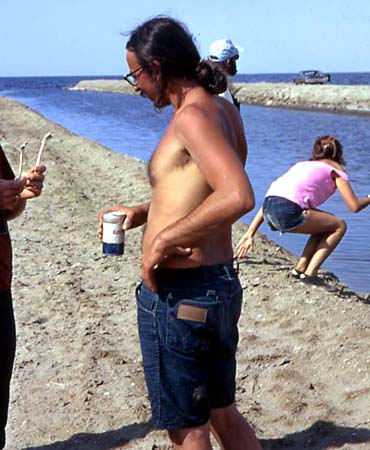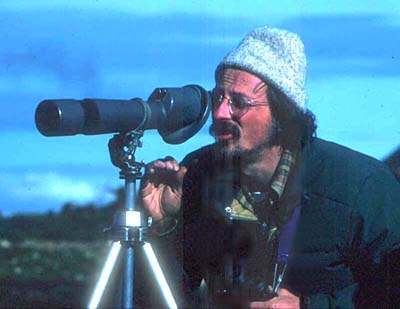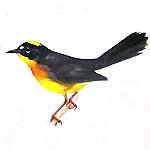 Dave
DeSante was an active California birder throughout our period of review
(1965-1989); he is best known for his work on the Farallones and for the
theory of "misorientation" that explains the presence of so many eastern
vagrants in California. He also did extensive field work in the high Sierra
and, by the end of the period, had formed his own organization for the
study of the dynamics of populations, endangered species, and migration:
the Institute of Bird Populations. Dave
DeSante was an active California birder throughout our period of review
(1965-1989); he is best known for his work on the Farallones and for the
theory of "misorientation" that explains the presence of so many eastern
vagrants in California. He also did extensive field work in the high Sierra
and, by the end of the period, had formed his own organization for the
study of the dynamics of populations, endangered species, and migration:
the Institute of Bird Populations.
Dave was at Stanford in the late sixties/early 70s. Indeed, he discovered a California Condor near campus in June 1971, the first Peninsula record since 1904, a bird publicized widely. Already known as an excellent field birder, he was appointed as an original member of the California Bird Records Committee (CBRC). He served on the CBRC for 9 of the first 10 years of its existence. Point Reyes Bird Observatory sent biologists to the Farallones beginning in 1967. DeSante began his studies there in 1970 as a PRBO staff member. He soon was involved in several first State records: they banded two Gray-cheeked Thrushes and a Le Conte's Sparrow that fall. These were the first in a series of vagrants that would prove to be first California records; he has an enviable list of prime finds to his credit. Dave continued his graduate work at Stanford through 1973, but continued to work on the Farallones throughout much of the 1970s, especially during spring and fall migrations. Studying the responses of captured migrants to the night sky, both natural and manipulated, led him to develop his theory that vagrants, especially eastern landbirds, were not disoriented, random migrants but strongly misoriented. They had a distinct orientation but in the 'wrong' direction. In further work, Dave developed evidence to support a theory of "mirror-image misorientation." If, say, a Canada Warbler should be oriented to fly to South America on an angle of10 degrees east of due south, and if so oriented, it would end up in South America with the assistance of trade winds. A "mirror-image misoriented" Canada Warbler would typically be oriented 10 degrees west of due south — the "mirror-image" of the "right" direction — and end up in California, accounting for the prevailing winds. As it became clear that certain species (e.g., Blackpoll Warbler, Palm Warbler) were occurring in coastal California outside of all probabilities, Dave's theory explained their presence. It became the topic of his PhD thesis (DeSante 1973). Many additional publications followed that built on his original studies. Photo 26 Aug 1972 Salton Sea © Van Remsen
|
|
 Dave
was (and is) a musician, and was very much a part of the "PRBO crowd" in
the early 1970s, an amorphous circle of comrades that included Rich Stallcup,
Dave Shuford, and Tim Manolis to varying degrees. They birded widely throughout
northern California, and were known for their counter-culture ways, their
parties, their Native American nicknames, and for their excellence as field
birders. Dave
was (and is) a musician, and was very much a part of the "PRBO crowd" in
the early 1970s, an amorphous circle of comrades that included Rich Stallcup,
Dave Shuford, and Tim Manolis to varying degrees. They birded widely throughout
northern California, and were known for their counter-culture ways, their
parties, their Native American nicknames, and for their excellence as field
birders.
Dave spent many summers in the late '70s and early '80s doing field work near Tioga Pass in the high Sierra, and helping from time to time with the Mono Lake Committee and its efforts to save Mono Lake. Dave was (and is) a passion advocate for saving endangered species and habitats. His interest in this work deepened over time, but not so much that he forsook field birding. Indeed, he (with Peter Pyle) published a listing oriented book in the mid-1980s (DeSante & Pyle 1986) that carefully evaluated and coded the distribution of all birds in every state and province of North America. Dave was also active as a Regional Editor for Audubon Field Notes/American Birds in the late 1960s and during the 1970s. He served as an editor in northern California for 14 seasons. photo 18 Dec 1988 Hall Ranch, Pt. Reyes MRN © D.
Roberson
|
|

Official Bird Name: Fan-tailed Warbler
Selected publications 1973-1989:
|